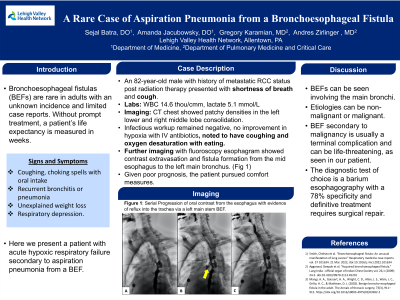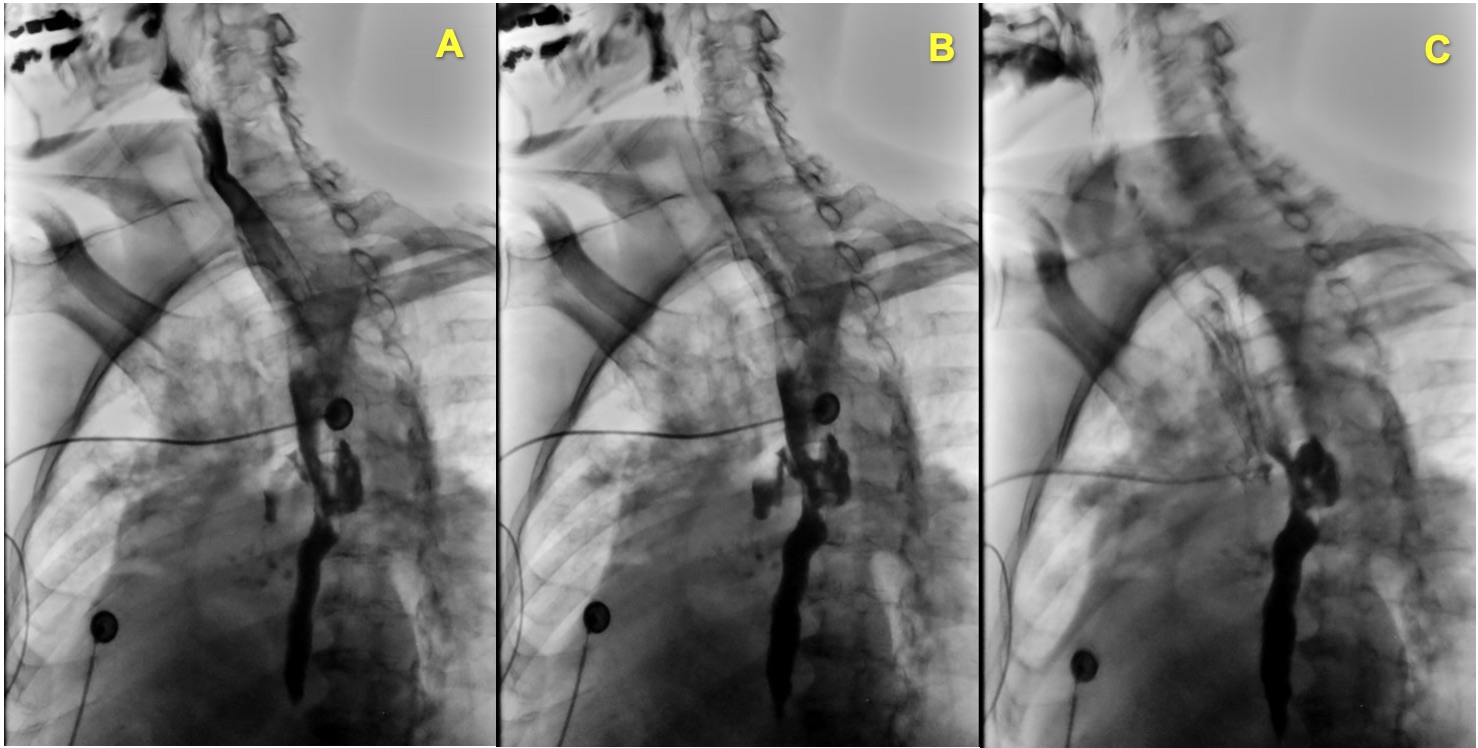Monday Poster Session
Category: Esophagus
P2260 - A Rare Case of Aspiration Pneumonia From a Bronchoesophageal Fistula
Monday, October 28, 2024
10:30 AM - 4:00 PM ET
Location: Exhibit Hall E

Has Audio

Sejal Batra, DO
Lehigh Valley Health Network
Allentown, PA
Presenting Author(s)
Sejal Batra, DO, Amanda Jacubowsky, DO, Andres Zirlinger, MD, Gregory Karamian, MD
Lehigh Valley Health Network, Allentown, PA
Introduction: Bronchoesophageal fistulas (BEFs) are rare in adults with an unknown incidence and limited case reports. Without prompt treatment, a patient’s life expectancy is measured in weeks. Here we present a patient with acute hypoxic respiratory failure secondary to aspiration pneumonia from a BEF.
Case Description/Methods: An 82-year-old male with history of metastatic renal cell carcinoma to the lung and bone status post radiation therapy to the left mainstem bronchus and chronic hypoxemic respiratory failure on 4L nasal cannula (NC) presented to the ED with one week of worsening shortness of breath and nonproductive cough. On arrival, he was tachypneic and hypoxic with SpO2 86%. Initial lab testing showed a WBC 14.6 thou/cmm, lactate 5.1 mmol/L, and otherwise was unremarkable. A CT chest with contrast showed patchy densities in the left lower lobe and right middle lobe consolidation with underlying metastatic tumor. With concerns for severe sepsis from community acquired pneumonia requiring high-flow NC, the patient was admitted to the medical ICU and was started on IV antibiotics. Further workup was negative for any infectious etiologies of pneumonia. His hypoxia and serial chest x-rays did not improve with antibiotic coverage. It was noted that he had significant coughing and oxygen desaturation with eating. Further imaging including a fluoroscopy esophagram without air showed contrast extravasation and fistula formation from the mid esophagus to the left main bronchus. After a multidisciplinary meeting, it was thought the BEF was due to prior radiation therapy of the lung metastasis from the patient’s renal cell carcinoma. With poor prognosis, the patient met with the palliative care team and pursued comfort measures.
Discussion: BEFs are rare in adults and often are seen involving the main bronchi. Etiologies can be non-malignant or malignant. Nonmalignant etiologies include trauma, prolonged intubation, iatrogenic from endoscopic evaluation, caustic ingestion, vasculitis, and infections. Esophageal cancer, lung cancer, and mediastinal lymphoma are common malignant causes. BEF secondary to malignancy is usually a terminal complication and can be life-threatening, as seen in our patient. Signs and symptoms of BEFs include coughing spells with oral intake, recurrent bronchitis or pneumonia, unexplained weight loss, and respiratory depression. The diagnostic test of choice is a barium esophagography with a 78% specificity and definitive treatment requires surgical repair.

Disclosures:
Sejal Batra, DO, Amanda Jacubowsky, DO, Andres Zirlinger, MD, Gregory Karamian, MD. P2260 - A Rare Case of Aspiration Pneumonia From a Bronchoesophageal Fistula, ACG 2024 Annual Scientific Meeting Abstracts. Philadelphia, PA: American College of Gastroenterology.
Lehigh Valley Health Network, Allentown, PA
Introduction: Bronchoesophageal fistulas (BEFs) are rare in adults with an unknown incidence and limited case reports. Without prompt treatment, a patient’s life expectancy is measured in weeks. Here we present a patient with acute hypoxic respiratory failure secondary to aspiration pneumonia from a BEF.
Case Description/Methods: An 82-year-old male with history of metastatic renal cell carcinoma to the lung and bone status post radiation therapy to the left mainstem bronchus and chronic hypoxemic respiratory failure on 4L nasal cannula (NC) presented to the ED with one week of worsening shortness of breath and nonproductive cough. On arrival, he was tachypneic and hypoxic with SpO2 86%. Initial lab testing showed a WBC 14.6 thou/cmm, lactate 5.1 mmol/L, and otherwise was unremarkable. A CT chest with contrast showed patchy densities in the left lower lobe and right middle lobe consolidation with underlying metastatic tumor. With concerns for severe sepsis from community acquired pneumonia requiring high-flow NC, the patient was admitted to the medical ICU and was started on IV antibiotics. Further workup was negative for any infectious etiologies of pneumonia. His hypoxia and serial chest x-rays did not improve with antibiotic coverage. It was noted that he had significant coughing and oxygen desaturation with eating. Further imaging including a fluoroscopy esophagram without air showed contrast extravasation and fistula formation from the mid esophagus to the left main bronchus. After a multidisciplinary meeting, it was thought the BEF was due to prior radiation therapy of the lung metastasis from the patient’s renal cell carcinoma. With poor prognosis, the patient met with the palliative care team and pursued comfort measures.
Discussion: BEFs are rare in adults and often are seen involving the main bronchi. Etiologies can be non-malignant or malignant. Nonmalignant etiologies include trauma, prolonged intubation, iatrogenic from endoscopic evaluation, caustic ingestion, vasculitis, and infections. Esophageal cancer, lung cancer, and mediastinal lymphoma are common malignant causes. BEF secondary to malignancy is usually a terminal complication and can be life-threatening, as seen in our patient. Signs and symptoms of BEFs include coughing spells with oral intake, recurrent bronchitis or pneumonia, unexplained weight loss, and respiratory depression. The diagnostic test of choice is a barium esophagography with a 78% specificity and definitive treatment requires surgical repair.

Figure: Serial progression of oral contrast on barium esophagram study.
Images A and B: Extravasation of contrast from the esophagus to the left mainstem bronchus via a Broncoesophageal fistula
Image C: Contrast regurgitation noted in the trachea
Images A and B: Extravasation of contrast from the esophagus to the left mainstem bronchus via a Broncoesophageal fistula
Image C: Contrast regurgitation noted in the trachea
Disclosures:
Sejal Batra indicated no relevant financial relationships.
Amanda Jacubowsky indicated no relevant financial relationships.
Andres Zirlinger indicated no relevant financial relationships.
Gregory Karamian indicated no relevant financial relationships.
Sejal Batra, DO, Amanda Jacubowsky, DO, Andres Zirlinger, MD, Gregory Karamian, MD. P2260 - A Rare Case of Aspiration Pneumonia From a Bronchoesophageal Fistula, ACG 2024 Annual Scientific Meeting Abstracts. Philadelphia, PA: American College of Gastroenterology.
